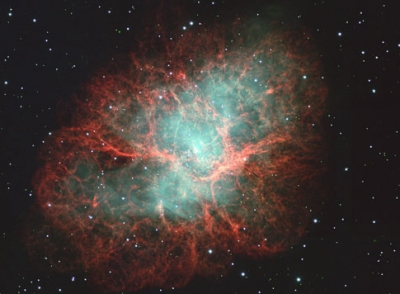
The Crab Nebula, the result of a supernova noted by Earth-bound chroniclers in 1054 A.D., is filled with mysterious filaments that are not only tremendously complex, but appear to have less mass than expelled in the original supernova and a higher speed than expected from a free explosion. The Crab Nebula spans about 10 light-years. In the nebula’s very center lies a pulsar: a neutron star as massive as the Sun but with only the size of a small town. The Crab Pulsar rotates about 30 times each second.
This beautiful nebula is relatively easy to locate due to its location near a bevy of bright stars and recognizable constellations. Although it can be seen at some time of night all year except from roughly May through July when the sun appears too close, the best observing comes from late fall through early spring.
To find the Crab Nebula, first draw an imaginary line from bright Betelgeuse in Orion to Capella in Auriga. About halfway along that line you will find the star Beta Tauri (or Elnath) on the Taurus-Auriga border.
Having identified Beta Tauri, backtrack a little more than a third of the way back to Betelgeuse and you should find the fainter star Zeta Tauri easily. Scanning the area around Zeta Tauri should reveal a tiny, faint smudge. It is located about a degree from the star (that’s about twice the width of a full moon) more or less in the direction of Beta Tauri.
Binoculars and small telescopes are useful for finding the object and showing its roughly oblong shape, but are not powerful enough to show the filimentary structure or any of its internal detail.
Picture Credit : Google




